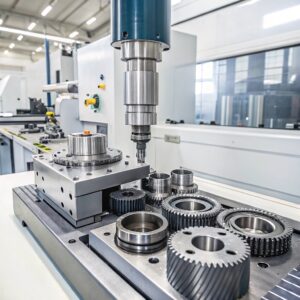An incremental rotary encoder is a device that transforms rotational motion into electrical signals. This process enables precise control and measurement in various systems. By generating signals in incremental steps, it helps you determine position, speed, and direction with remarkable accuracy. For example, quadrature encoders enhance resolution by producing four reference points per line, ensuring precise motion control.
These encoders play a vital role in modern industries. They are indispensable in automation, robotics, and industrial systems, where accurate data is crucial for efficient operations. The growing demand for automation and advancements in technology have made incremental rotary encoders a key component in smart manufacturing and Industry 4.0.
Key Takeaways
-
Incremental rotary encoders change spinning motion into electrical signals. This helps control position, speed, and direction accurately.
-
These encoders are affordable and strong, perfect for industries like factories and automation where cost and dependability are important.
-
Their simple design makes them easy to use and fix. They work well in systems like conveyor belts and robots.
-
Incremental rotary encoders can handle both spinning and straight-line motion. They help improve efficiency in many technologies.
-
As automation and smart factories grow, these encoders are key. They make processes better and more accurate.
How does an incremental rotary encoder work?
Image Source: unsplash
Working principle
An incremental rotary encoder converts mechanical rotation into electrical signals. It uses a fixed light source and a rotary disc with alternating opaque and transparent sections. As the disc rotates, light passes through the transparent sections and gets blocked by the opaque ones. This process generates a series of pulse signals, which represent the movement of the shaft. These signals are typically square waves, making them easy to interpret.
The encoder produces three main outputs: A, B, and Z. Channels A and B generate square wave pulses that are 90 degrees out of phase. This phase difference helps you determine the direction of rotation. The Z channel, also called the index channel, provides a single pulse per revolution. This pulse is useful for resetting or verifying the position. By counting the pulses and analyzing their phase relationship, you can measure position, speed, and direction accurately.
Each rotation of the encoder shaft generates a fixed number of pulses. This number depends on the encoder's design and determines its resolution. Higher resolution encoders provide more precise measurements.
Key components
An incremental rotary encoder consists of several essential parts. The rotary disc, often made of glass or plastic, has alternating opaque and transparent sections. A light-emitting diode (LED) shines light through the disc, while a photo detector captures the light that passes through. This interaction creates the pulse signals.
The encoder also includes channels A and B for direction sensing. These channels output signals that are 90 degrees out of phase. The Z channel, or index channel, provides a reference point for each revolution. Some encoders use magnetic sensors instead of optical ones. These sensors detect changes in magnetic fields to generate signals, offering an alternative to light-based systems.
| Component | Function |
|---|---|
| Rotary Disc | Contains opaque and transparent sections to modulate light. |
| LED | Emits light that passes through the rotary disc. |
| Photo Detector | Captures light and converts it into electrical signals. |
| A and B Channels | Provide phase-shifted pulse outputs for direction detection. |
| Z Channel | Offers a single pulse per revolution for position verification. |
These components work together to ensure the encoder delivers accurate and reliable data for motion control.
Advantages of incremental rotary encoders
Cost-effectiveness
An incremental rotary encoder offers an affordable solution for motion control and measurement. Its design focuses on delivering essential features like speed and position tracking without unnecessary complexity. This makes it a cost-effective choice for applications where absolute position data is not required. For example, industries like manufacturing and automation rely on these encoders to optimize processes without overspending on advanced systems.
You can also benefit from their durability. These encoders are built to last, reducing the need for frequent replacements or repairs. This longevity further lowers operational costs, making them a practical option for budget-conscious projects.
Simplicity
The simplicity of an incremental rotary encoder lies in its straightforward design and operation. It generates pulse signals that are easy to interpret, ensuring seamless integration into various systems. You don’t need advanced tools or expertise to set up or maintain these encoders. This ease of use makes them ideal for applications requiring basic speed and position information, such as conveyor systems or elevators.
-
Key benefits of simplicity include:
-
Consistent performance due to repeatability.
-
Fast response times for real-time applications.
-
Low power consumption, which is perfect for energy-efficient systems.
This uncomplicated design ensures reliability and robustness, even in demanding environments.
Flexibility
Incremental rotary encoders are highly versatile. You can use them in a wide range of applications, from robotics to CNC machines. Their ability to measure relative position changes and velocity makes them suitable for dynamic systems. Whether you need to control motor speed or track movement in automation, these encoders adapt to your needs.
Another advantage is their compatibility with different technologies. Optical and magnetic sensing options allow you to choose the best fit for your specific requirements. This flexibility ensures that you can implement these encoders in diverse scenarios without compromising performance.
With their cost-effectiveness, simplicity, and flexibility, incremental rotary encoders provide a reliable solution for motion control in various industries.
Types of incremental encoders
Rotary incremental encoders
Rotary incremental encoders are designed to measure rotational motion. They are widely used in applications requiring precise control of angular position or speed. These encoders generate electrical signals as the shaft rotates, allowing you to track movement with high accuracy. Their compact design makes them suitable for systems with limited space, such as robotics and motor control.
Rotary encoders excel in dynamic environments. They provide stable performance even under challenging conditions. For example, their high repeatability ensures consistent measurements, reducing the risk of errors. Additionally, their fast response time allows real-time adjustments, which is essential for maintaining stability in rapidly changing systems.
| Metric | Description |
|---|---|
| Accuracy | Ensures precise position measurements for control applications. |
| Repeatability | Delivers consistent results across multiple measurements. |
| Response Time | Reacts quickly to changes in displacement for real-time control. |
| Lifespan | Offers long operational life, minimizing maintenance needs. |
| Reliability | Performs reliably in various conditions, reducing failure rates. |
| Signal Stability | Transmits accurate data without signal fluctuations. |
| Power Consumption | Operates efficiently with low energy requirements. |
| Temperature Range | Functions effectively across a wide range of temperatures. |
| Size and Weight | Compact and lightweight, ideal for space-constrained applications. |
| Material and Structure | Built to withstand harsh environments, ensuring durability. |
Rotary incremental encoders are a versatile choice for industries like manufacturing, automation, and robotics. Their ability to deliver precise and reliable data makes them indispensable in motion control systems.
Linear incremental encoders
Linear incremental encoders measure straight-line motion. They are commonly used in systems that require accurate position feedback along a linear path. These encoders work by detecting changes in position and converting them into electrical signals. You can find them in applications like CNC machines, measuring instruments, and assembly lines.
In manufacturing, linear encoders ensure precise measurements, which are critical for maintaining quality standards. For example, they provide accurate position feedback in measuring instruments, enabling you to achieve high precision. In the automotive industry, they play a key role in assembly processes, ensuring components are manufactured and aligned with exact specifications.
| Industry | Application Description | Importance of Encoders |
|---|---|---|
| Manufacturing | Accurate position feedback for measuring instruments | Ensures precise measurements, critical for quality control and stringent measurement standards. |
| Automotive | Precision in manufacturing and assembly processes | Provides necessary feedback for high accuracy in component manufacturing and assembly. |
| Aerospace | Accurate position feedback in aircraft manufacturing and maintenance | Critical for high precision and reliability in aerospace applications, driving adoption in the sector. |
Linear incremental encoders are essential for systems that demand high accuracy and reliability. Their ability to provide precise feedback makes them a valuable tool in modern industries.
Applications of incremental rotary encoders
Image Source: unsplash
Industrial automation
You can find incremental rotary encoders at the heart of industrial automation systems. These devices provide precise position and speed feedback, which is essential for controlling automated machinery. For example, in conveyor systems, they help track the movement of items, ensuring accurate sorting and placement. Their ability to deliver real-time data makes them indispensable for maintaining efficiency in production lines.
The growing demand for automation has significantly increased the use of these encoders. Industry 4.0 and smart manufacturing rely heavily on precise position sensing to optimize processes. The table below highlights how incremental rotary encoders contribute to process efficiency in industrial automation:
| Evidence Type | Description |
|---|---|
| Market Growth | The incremental rotary encoder market has grown due to advancements in technology and automation demand. |
| Application | Widely used in industrial automation, robotics, and automotive systems to enhance efficiency. |
| Industry Trends | Industry 4.0 emphasizes precise position sensing for modern automated processes. |
By integrating these encoders into your systems, you can achieve higher productivity and reduce errors in automated workflows.
Motor control
Incremental rotary encoders play a critical role in motor control applications. They provide feedback on the motor's position, speed, and direction, enabling precise adjustments. This feedback ensures that motors operate efficiently and meet performance requirements. For instance, in electric vehicles, these encoders help regulate motor speed, improving energy efficiency and performance.
You can also use them in industrial motors to maintain consistent torque and speed. Their ability to deliver accurate data in real time makes them ideal for dynamic systems. Whether you are controlling a small servo motor or a large industrial motor, these encoders ensure smooth and reliable operation.
Robotics
In robotics, incremental rotary encoders are essential for precise motion control. They allow robots to track their movements and adjust their positions accurately. For example, robotic arms use these encoders to perform tasks like assembling components or welding with high precision. Without accurate feedback, robots would struggle to complete such tasks efficiently.
You can also use these encoders in mobile robots to monitor wheel rotations and calculate distances traveled. This capability is crucial for navigation and obstacle avoidance. Their compact size and high reliability make them a perfect fit for robotic systems, where space and accuracy are critical.
Incremental rotary encoders empower robots to perform complex tasks with precision, making them a cornerstone of modern robotics.
CNC machines
CNC (Computer Numerical Control) machines rely on precision to deliver high-quality results. Incremental rotary encoders play a key role in achieving this precision. These encoders provide accurate feedback on position and speed, ensuring the machine operates smoothly and efficiently. By converting mechanical motion into electrical signals, they help you control the machine's movements with great accuracy.
One critical area where incremental rotary encoders excel is spindle speed control. They monitor the spindle's revolutions per minute (RPM) with precision, allowing you to optimize cutting speeds and tool life. This ensures consistent performance and reduces wear on tools. Another advantage is their ability to enhance precision homing. With a high line count, such as 5000 lines, these encoders can achieve positioning accuracy within .072 mechanical degrees. This level of precision is essential for tasks like drilling, milling, and cutting.
| Metric | Description |
|---|---|
| Spindle Speed Control | Incremental rotary encoders enable precise monitoring of spindle speed (RPM), crucial for optimizing feeds, speeds, and tool life. |
| Precision Homing | With a 5000 line count, incremental encoders provide precision within .072 mechanical degrees, enhancing accuracy in positioning. |
You can also use incremental rotary encoders to improve the overall efficiency of CNC machines. Their real-time feedback ensures that the machine responds quickly to changes, reducing errors and downtime. This makes them an indispensable component in industries like manufacturing and aerospace, where precision and reliability are critical.
By integrating incremental rotary encoders into CNC machines, you can achieve better control, higher accuracy, and improved productivity. These benefits make them a valuable tool for modern machining processes.
Incremental rotary encoders convert rotational motion into precise electrical signals, making them essential for motion control and position measurement. Their working principle, based on pulse generation, ensures accurate feedback for speed, direction, and position. These encoders stand out for their cost-effectiveness, simplicity, and flexibility, making them suitable for diverse applications like robotics, CNC machines, and industrial automation.
The growing demand for automation and smart manufacturing highlights their importance. Industries increasingly rely on incremental rotary encoders to enhance efficiency and accuracy. With advancements in IoT and AI, these encoders play a vital role in modernizing automated processes. Exploring their capabilities can provide you with a reliable and versatile solution for your motion control needs.
FAQ
What is the difference between incremental and absolute rotary encoders?
Incremental encoders measure relative position changes using pulse signals. Absolute encoders provide a unique position value for every shaft angle. Incremental encoders are simpler and cost-effective, while absolute encoders offer precise absolute positioning.
Tip: Choose incremental encoders for speed and direction tracking, and absolute encoders for exact position data.
What does the resolution of an incremental rotary encoder mean?
Resolution refers to the number of pulses generated per revolution of the encoder shaft. Higher resolution means more precise measurements. For example, an encoder with 1000 PPR (pulses per revolution) provides finer position feedback than one with 500 PPR.
What are the common output signals of an incremental rotary encoder?
Incremental encoders typically output three signals: A, B, and Z. Channels A and B provide phase-shifted pulses for direction sensing. The Z channel, or index pulse, offers a single pulse per revolution for position reference.
What industries benefit most from incremental rotary encoders?
Industries like manufacturing, robotics, and automotive benefit greatly. These encoders enhance automation, motor control, and precision tasks. For example, they optimize conveyor systems in factories and improve robotic arm accuracy.
Note: Incremental encoders are also widely used in CNC machines for precise cutting and drilling.
What maintenance do incremental rotary encoders require?
Regular cleaning of the optical disc and sensors ensures optimal performance. Check for wear and tear on mechanical parts. Magnetic encoders may require less maintenance due to their robust design.
Tip: Follow the manufacturer’s guidelines for maintenance to extend the encoder’s lifespan.







